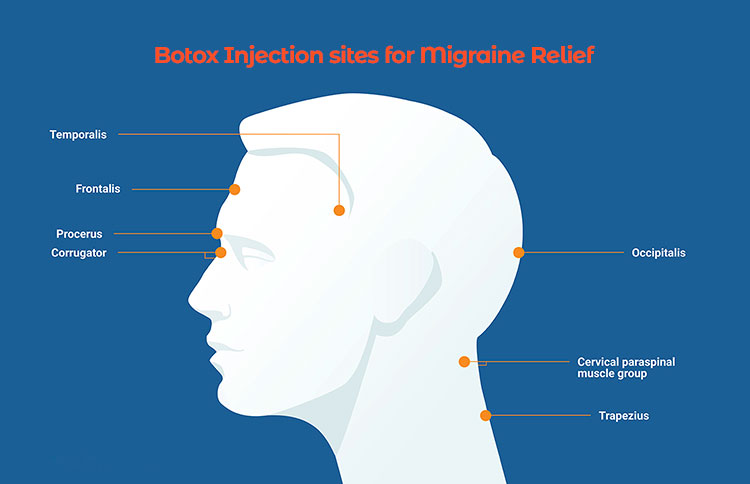
Botox for Migraine
Treating Migraine with Botox
At least 2% of the population suffers from chronic migraine, a disorder that can be very disabling in terms of pain, quality of life, missed workdays, and interruption of usual activities throughout the month. This neurological disease can cause debilitating throbbing pain that can leave you in bed for days! Movement, light, sound and other triggers may cause symptoms like pain, tiredness, nausea, visual disturbances, numbness and tingling, irritability, difficulty speaking, temporary loss of vision and many more.
Botulinum toxin injectables that are commonly used as Wrinkle-reducing treatments may also be used to treat chronic migraines. These injectables, known as neuromodulating drugs, were approved by the U.S. Food and Drug Administration (FDA) in 2010 for migraine treatment.
In October 2010, Botoxulinum A was approved as a preventive strategy for patients having headaches most days of the month. This approval was based upon 2 trials that demonstrated decreased number of headache days, decreased hours of headache, and improved function with administration of Botox.
When you have a migraine, your body releases substances called neurotransmitters and molecules that carry pain signals from your brain. Botulinum toxin interferes with the transmission of these substances, typically where the nerves and muscles meet. It works like a roadblock in the pathway. When the drug is injected into the muscles around the face, head and neck, it stops the chemicals before they get to the nerve endings around your head and neck and thereby interferes with pain-associated neurotransmission
Using a very small needle, a specialist injects Botulinum toxin into the tiny muscles under your skin throughout various areas around your face (forehead, temples), head and neck. Sometimes the specialist will inject areas called “trigger points” where the headache pain originates.

Botox works as an effective preventive intervention in many migraineurs. When it works for chronic migraine, the results can be dramatic, not just in reducing headache days, but reducing all disabling aspects of daily headaches.

It can take several weeks and multiple treatments before you start experiencing relief from your migraines. Patients may take 4 weeks after injection to notice benefit, although many see improvement sooner. There is good evidence that when it works, Botox has a cumulative effect, with better and better response with each cycle administered every 4-6 months across a year. Therefore, patience is a virtue and trying Botox for 2–3 cycles may yield benefit not seen with just one set of injections. However, after 2–3 sets of injections, if no improvement is noticed, Botox should probably be discontinued. For those who do respond, injections are continued every 4-6 months.
Some patients find they can discontinue injections without frequent migraines returning. Others need regular treatments to keep migraines under control. To test whether it can be discontinued, the injections are spaced further apart and if the headaches do not increase, the Botox may be stopped.
Chronic migraine is an important problem for at least 2% of the population, having an adverse impact upon an individual’s quality of life, as well as that of their families. Botox is the first approved intervention found to result in a significant improvement in this disorder. While it does not result in cure, it represents a breakthrough in effective treatment.